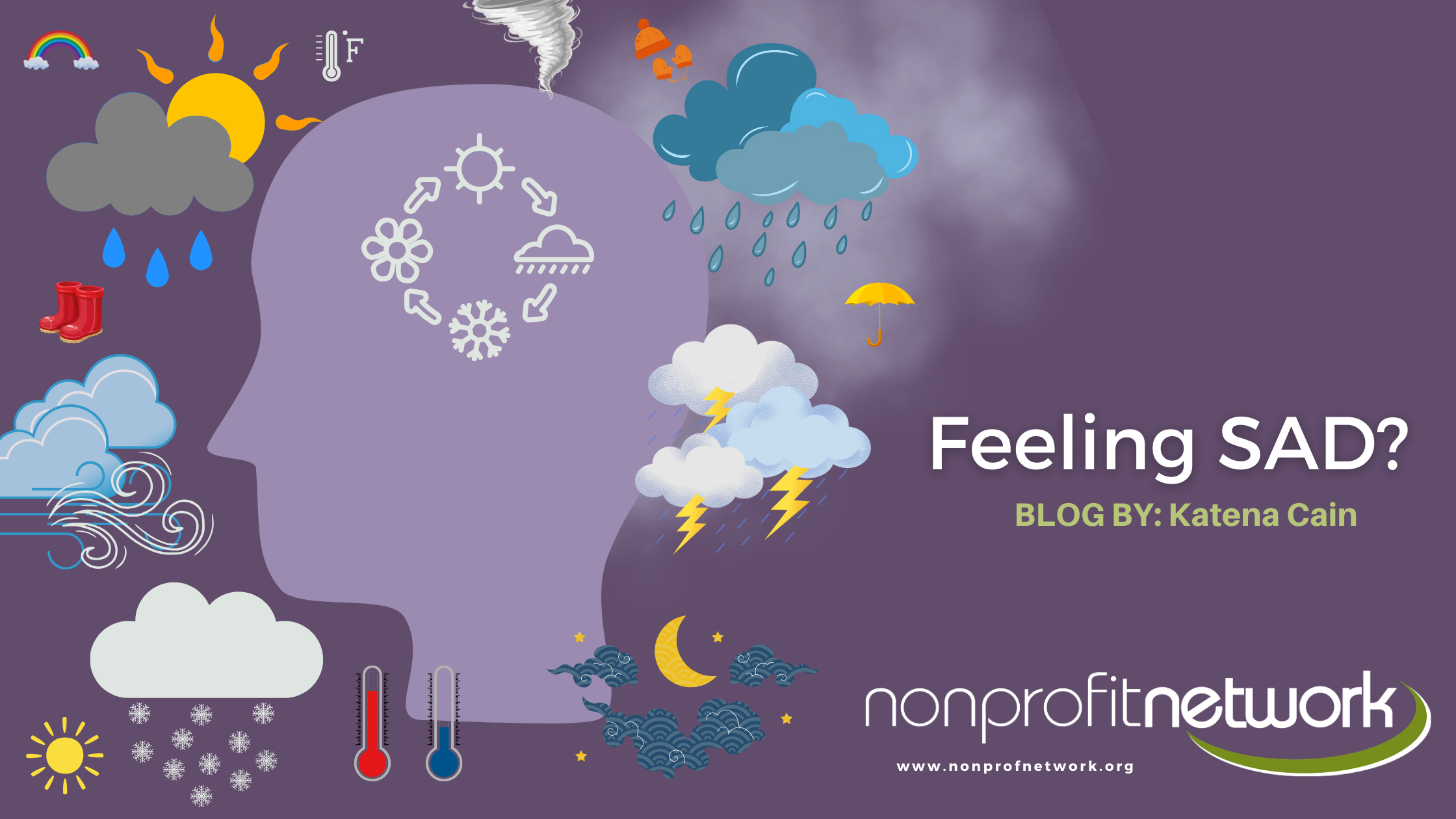

Katena Cain, PhD.
Nonprofit Management Consultant
Are you feeling SAD?
My work, in the Nonprofit sector, began over 35 years ago and started at a young age with my dad taking my sister and I along with him as he would volunteer in local elder care facilities, food pantries and doing odd jobs for free for people who were under resourced and unseen in our community. The spark that I saw in his eyes and those being served were priceless and I wanted to always be in spaces where I could assist – nonprofit spaces, mission-driven spaces, and community-organized spaces.
As my work continued and still continues (where I started getting paid), I had and have the spark in my eyes just like his. The only exception, where the spark faded, was during the months of January-March where I experienced mood changes that didn’t bring me joy, especially in my work. I soon realized that I could be experiencing something more serious. I visited a doctor, who shared with me that I had Seasonal Affective Disorder or SAD and we quickly took the necessary steps to make sure that we got it under control. The National Institute of Mental Health, shares that Seasonal Affective Disorder or SAD is a type of depression characterized by a recurrent seasonal pattern, with symptoms lasting about 3−5 months out of the year.
While this is my story, I understand the realm of nonprofit work, where individuals are driven by a profound commitment to social change, the prevalence and impact of seasonal mood and behavioral changes often go unrecognized. We navigate a unique landscape where our dedication to societal betterment meets the demands of an often emotionally taxing profession.
In doing some further research about the toll that it takes on nonprofit employees who experience SAD, this is what I found.
Key Findings:
- Hidden Struggle: SAD manifests in subtle ways within the nonprofit sector. The emotional toll of the work, coupled with the intrinsic highs and lows, contributes to a hidden struggle that nonprofit employees often grapple with in silence.
- Passion and Resilience: Nonprofit professionals are propelled by a deep-seated passion for creating positive change. However, this passion can be both a driving force and a potential source of vulnerability, amplifying the emotional impact of SAD on their resilience.
- Voices of Resilience: Despite the challenges, numerous nonprofit employees exhibit remarkable resilience in the face of SAD. Personal narratives from these individuals serve as powerful testimonials, offering insights into coping mechanisms and strategies for navigating mental health challenges in a nonprofit context.
- Stigma and Silence: A pervasive stigma surrounding mental health discussions often leads to a culture of silence within nonprofit organizations. Breaking this silence is crucial to fostering a supportive environment where employees feel empowered to share their experiences without fear of judgment.
- Organizational Impact: SAD has tangible effects on workplace dynamics, potentially leading to decreased productivity, increased absenteeism, and compromised overall staff well-being. Recognizing and addressing these impacts is essential for maintaining a healthy and sustainable nonprofit workforce.
Recommendations:
- Cultivate a Supportive Culture: Nonprofit organizations should actively work towards cultivating a workplace culture that prioritizes and supports the mental well-being of their employees. This includes fostering open dialogues about mental health, providing resources, and establishing support systems.
- Flexible Work Policies: Implementing flexible work policies can be instrumental in accommodating the unique challenges posed by SAD. Offering options such as remote work, flexible hours, and mental health days can contribute to a more adaptive and understanding workplace.
- Educational Initiatives: Promoting awareness and education about SAD within nonprofit organizations is crucial. Training sessions, workshops, and resources can help employees and leadership better understand the condition and develop strategies for managing mental health effectively.
- Leadership Advocacy: Nonprofit leaders play a pivotal role in setting the tone for organizational culture. Advocacy for mental health, destigmatization efforts, and leading by example in prioritizing well-being send a powerful message that resonates throughout the organization.
Conclusion: In conclusion, addressing SAD among nonprofit employees requires a multifaceted approach that combines awareness, destigmatization, and strategic support. By recognizing and acting upon the unique challenges faced by these dedicated individuals, nonprofit organizations can foster a workplace environment that not only celebrates purpose-driven work but also prioritizes the mental health and well-being of its invaluable workforce.
Love and peace to all
-Katena Cain, PhD
This blog was written with research explored by the National Institute of Mental Health - https://www.nimh.nih.gov/health/publications/seasonal-affective-disorder
Want more? Click here to sign up for our weekly e-newsletter. Each week you'll get a link to the most recent news, workshops, and blog post. We promise to respect your time and will not flood your inbox. We only send one newsletter email each week and when any timely important announcements need to be made.

